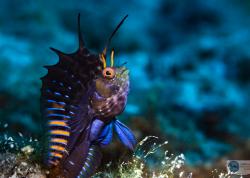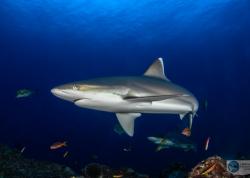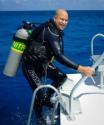Three Crazy Critters of the Dauin Coast
The Dauin coast near the city of Dumaguete, in the Philippines, consistently rates as one of the top muck diving spots in the world and is home to some of the strangest and most rare critters. On a recent Bluewater Photo workshop aboard the Philippine Siren and a stay at the luxurious boutique Atmosphere Resort and Spa, I was able to rack up a lot of bottom time along the Dauin coast. Adding to the quality of diving here year-round was the fact that from February through March there are baby frogfish everywhere, including numerous species with eggs and lots of mating behavior.
When asked what my favorite critters of Dauin are, it is a bit like picking your favorite child. There are the mating mandarinfish on the Atmosphere house reef, several species of ornate ghost pipefish, colorful nudibranchs littering the seafloor, flamboyant cuttlefish hunting at night, highly sought after octopus (mimic, blue-ring, wonderpus, coconut, etc.), interesting crustaceans and those cute little baby frogfish stretching their jaws and fishing with their lures. So when choosing my top three crazy critters of Dauin, I picked three interesting subjects that have interesting stories behind the photograph to share.
All of the images below where taken with a Nikon D800 and 105mm lens in a Sea&Sea D800 housing with dual Sea&Sea YS-250 strobes and Sola 800 focus light.
Orangutan Crab (Achaeus japonicas)
ISO 200, F/18, 1/250 sec

At first glance, one might think this type of spider crab is a commonly photographed subject. Those that have found them know they are typically found in bubble coral. But many of the photos I have seen and that I have taken seem a little blurry, and the hair on the crab is hard to distinguish. I spoke with the resident biologist at Atmosphere Resort, Daniel Geary, and he instructed that I have to find a crab that is perched on the outside of the coral that is in current so that the hair looks like it is freshly combed. That allows you to take a sharper and more impactful photo. Equipped with this new knowledge we went out on the house reef and found several Orangutan crabs that I passed for photos until finally discovering the one pictured here. The result is much better than I had taken before.
Orange Bobtail Squid (Euprymna scolopes)
ISO 200, F/22, 1/250 sec

Bobtail squid are one of my favorite cephalopods to try and find on a night dive and the Dauin coast is prime territory for them. We had spotted two of the common blue/purple colored bobtails on the night dive already and then came across this less frequently seen orange one that was about an inch long. It was the first one that Daniel had ever seen on that site and we were both quite excited. We watched it hunt around the bottom and eventually burrow down in the sand so that only its eyes were peaking out. If you have ever photographed a bobtail squid you may have noticed that the edge of the squid is always blurry. It turns out that it is not your photography skills, but rather a bioluminescent bacteria that filters the light and creates that blur to help conceal its silhouette.
A tip for photographing cephalopods is to use a focus light with an amber filter so that the pupil of the eye will dilate more. The first picture was taken when I first found the squid and before I had switched the light to amber, so the squid is closing its pupil. The second one was taken with the amber light mode.

The Donald Duck Shrimp (Leander plumosus)
ISO 100, F/29, 1/250 sec with a ReefNet SubSee +5 Diopter

When I asked my dive masters what they consider to be one of the craziest sought after critters that divers want to photograph, they all said the Donald Duck Shrimp! I had never heard of it and when they started to describe it to me with this big long orange bill like a duck I thought they were joking with me. Then they started to talk like a duck and all laugh and I thought for sure I had been punk’d. But two dives later when they were pointing inside a small white sponge at a tiny orange thing floating around in the water column and making a duck bill sign over their regulator, I realized they were not joking around. The shrimp, which was less than half an inch long, actually did have an oversized hairy bill (or more precisely, a rostrum). It was pretty funny looking for sure and made for an interesting, but challenging photo subject. In order to get the necessary detail of the tiny shrimp, I had to flip on my diopter, which has a very narrow depth of field but razor sharp focal plane. Using my back button to focus down to the minimum distance I waited until the shrimp became parallel with the lens and in focus before firing away with the shutter. It took several attempts, but I was able to capture a nice portrait of this funny little guy.
![]()
Book the perfect dive & photo trip to Atmosphere Resort in Dumaguete, Philippines with Bluewater Travel.
RECOMMENDED ARTICLES
SUPPORT THE UNDERWATER PHOTOGRAPHY GUIDE:
The Best Service & Prices on u/w Photo Gear
 Visit Bluewater Photo & Video for all your underwater photography and video gear. Click, or call the team at (310) 633-5052 for expert advice!
Visit Bluewater Photo & Video for all your underwater photography and video gear. Click, or call the team at (310) 633-5052 for expert advice!
The Best Pricing, Service & Expert Advice to Book your Dive Trips
 Bluewater Travel is your full-service scuba travel agency. Let our expert advisers plan and book your next dive vacation. Run by divers, for divers.
Bluewater Travel is your full-service scuba travel agency. Let our expert advisers plan and book your next dive vacation. Run by divers, for divers.



































